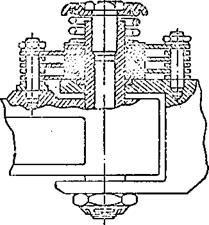Damping of Oscillatory Blade Motions
If we combine all the forces acting on the blade in the hub rotation plane, we obtain their resultant R. In the case of equilibrium relative to the vertical hinge, the resultant R, shifted to the hinge axis, lies along the blade axis and its moment will be zero. We resolve the force R into two components (Figure 47b): R^ and Q^. The force R^ is radial, and its moment about the hub axis is zero. The force creates the moment Q^a, which
twists the rotor shaft. Both the magnitude and moment of the force will change with variation of the lag angle. Consequently, the oscillatory motions of the blades about the vertical hinges are the source of torsional vibrations of the shaft, while variation of the force R^ leads to bending vibrations of the shaft. Various types of dampers are used to eliminate the oscillatory motions (free oscillations) of the blades relative to the vertical hinges.
The dampers may be of two types: friction and hydraulic.
The friction dampers consist of a set of steel and cermet (friction) disks (Figure 48). Half of the steel disks are attached to the intermediate link of the hub, the other half is attached to the body of the axial hinge.
The friction disks, designed to increase the friction force, are located between the steel disks.
The disks are compressed from above by a spring, which is tightened by a bolt which screws into the finger of the vertical hinge. As the blade rotates about the vertical hinge, friction forces develop between the disks.
|
|
|
|
helicopters the damping moment varies
The moment of these forces about the vertical hinge axis will be the damping moment. The magnitude of the damping moment can be regulated by tightening the bolt. On modern from 80 to 120 kgf’m.
The magnitude of the damping moment must be monitored during operations, and care must be taken that it is the same for all the main rotor dampers. /67
With a damper installed, the blade rotates relative to the vertical hinge if the torque exceeds the damping moment. This means that the root portion of the blade experiences a load which does not exceed the magnitude of the damping moment, i. e., the blade root is relieved of a large bending moment. At the same time, the blade will not have free oscillations about the vertical hinge, which means that there will be no reason for the onset of severe vibrations.
The friction dampers can be used on light and intermediate helicopters (Mi-1, Mi-4). They are not used on heavy helicopters because of the small magnitude of the damping moment and the frequent damper regulation required. The hydraulic dampers are being used more and more at the present time.
The hydraulic damper consists of a cylinder and a rod and piston (Figure 49). The cylinder is attached to the body of the vertical hinge, while the rod is attached to the finger of the horizontal hinge. In the piston there are calibrated orifices with relief valves.
As the blade rotates relative to the vertical hinge, the rod and piston
displace relative to the cylinder. The cylinder cavities are filled with a
liquid. As the piston moves in the cylinder, the liquid opens the relief
valves and flows from one cavity into the other through orifices in the piston.
The resistance force P is developed. The moment of this force about the
vertical hinge axis M = Pa will be the damping moment. This moment is easily
9
regulated by selecting the piston area, diameter of the orifices in the piston, and lever arm a (from the damper axis to the vertical hinge axis).
Hydraulic dampers have the following drawbacks:
low damping moments for low rates of blade rotation relative to the vertical hinge;
marked increase of the damping moments during rapid rotation;
dependence of the damping moments on temperature because of variation of the liquid viscosity;
marked variation of the damping moments if air gets into the cylinder chamber.
The hydraulic dampers are sometimes supplemented with spring dampers to eliminate the first problem.
The second problem is eliminated by proper choice of the relief valves. /68
The third problem is alleviated by selection of a liquid whose viscosity depends very little on temperature.
To prevent air entry into the damper, a small supply reservoir is installed on the root portion of the blade, and the damper cavities are replenished with the working fluid from this.













